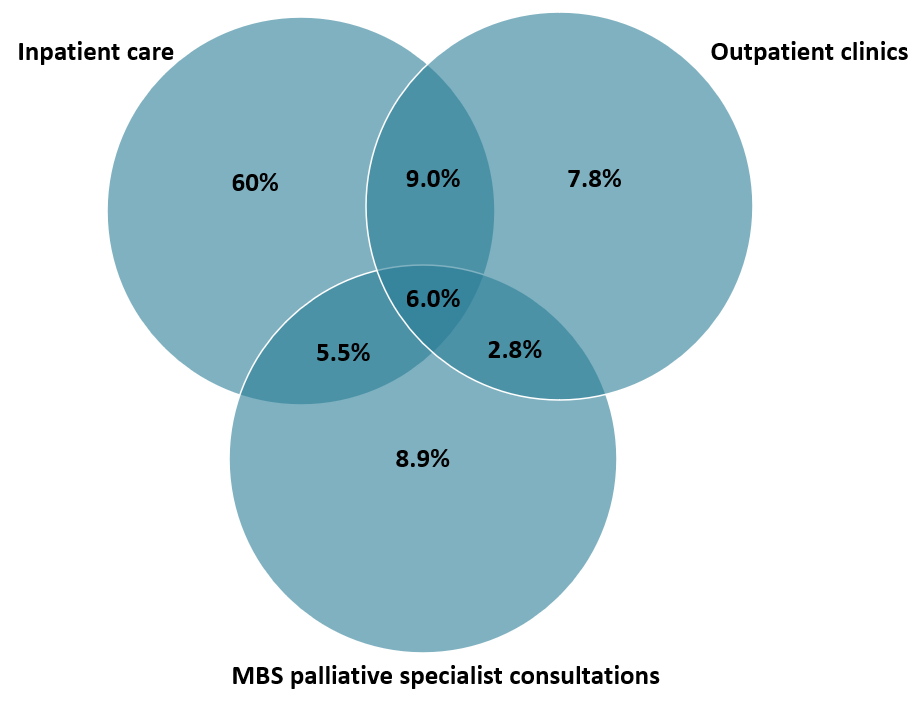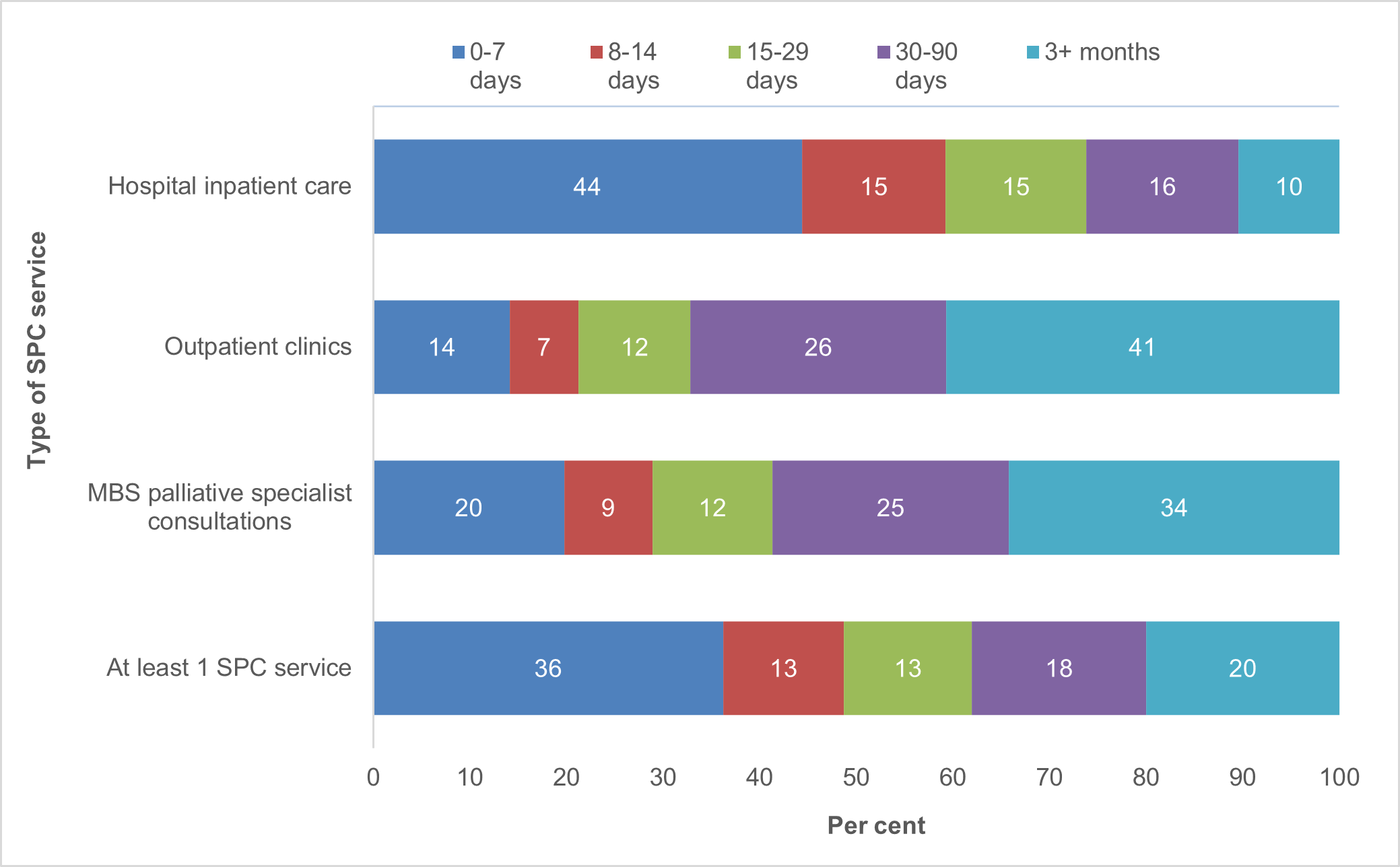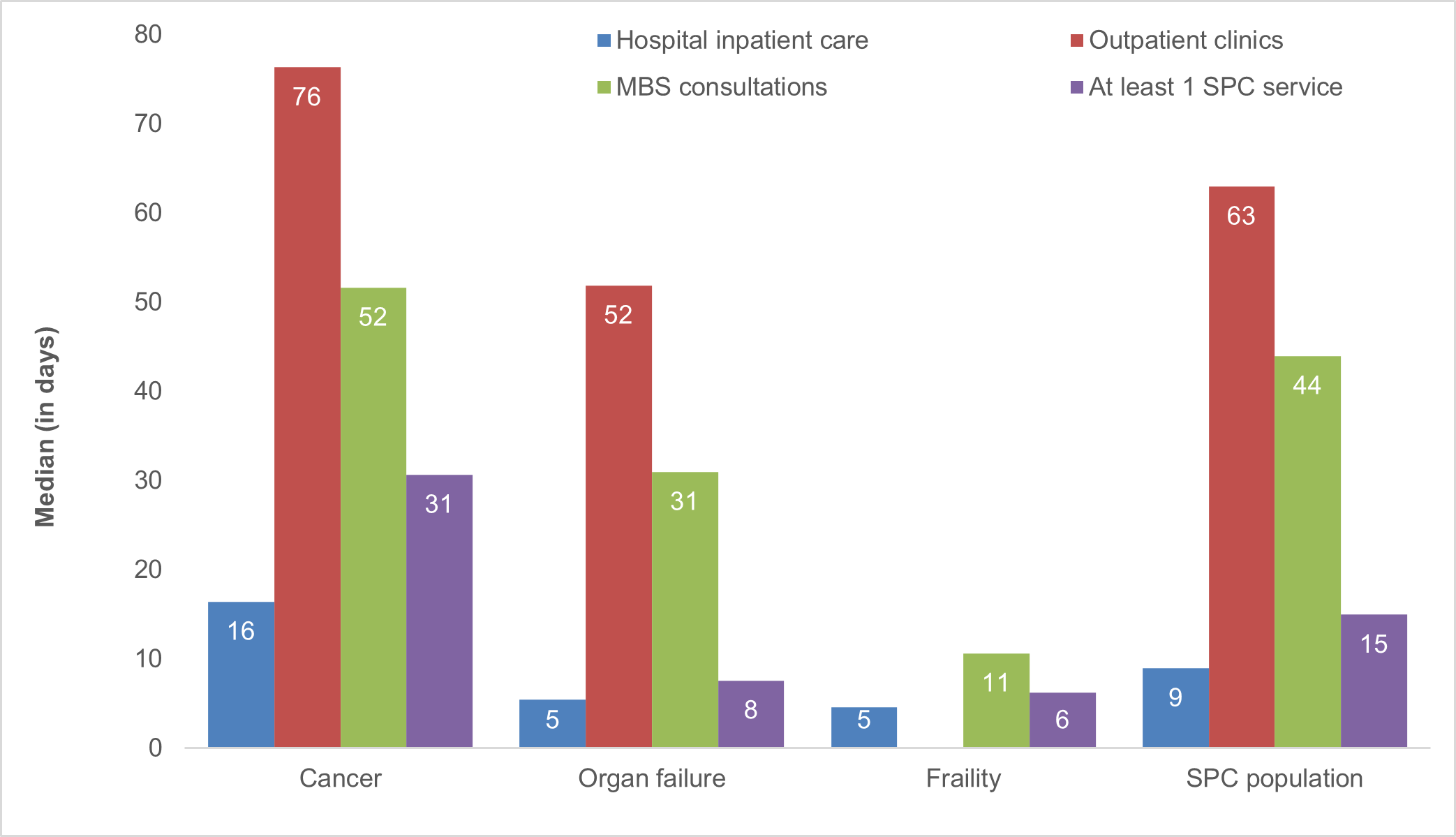Access to specialist palliative care
4 in 5 received SPC as inpatients and 1 in 4 through MBS palliative specialist consultations
Of the 52,105 people who received SPC in the last year of life and died from predictable deaths in 2019–20 (SPC population), 80% received SPC as inpatients, 26% in outpatient clinics through consultations with palliative care specialists and 23% had consultations with palliative care specialists/physicians (through MBS claims (Figure 3.3).
Examining each type of SPC service separately can overlook the fact that people often use a mix of SPC services, particularly towards the end of life, as shown in Figure 3.3. For the SPC population:
- 3 in 4 (77%) received SPC in only 1 of the above settings – 60% inpatient care, 7.8% outpatient clinics and 8.9% MBS palliative specialist consultations
- 1 in 6 (17%) received SPC in 2 settings – 9.0% inpatient care and outpatient clinics, 5.5% inpatient care and MBS palliative specialist consultations, and 2.8% MBS palliative specialist consultations and outpatient clinics, and
- 1 in 16 (6.0%) received SPC in all 3 settings in the last year of life.
Figure 3.3: Types of SPC services received in the last year of life, for the SPC population

Source: Supplementary Table 3b.
SPC is received on average 15 days before death
Among the 52,105 people in the SPC population:
- almost 2 in 3 (62%) first received SPC services in the last month of life and 49% in the last 2 weeks of life
- 1 in 5 (20%) first received SPC services at least 3 months before death (see Figure 3.4).
- The median number of days from receipt of first SPC service (in last year of life) to death for the SPC population was 15 days (see Supplementary Table 6c).
While these findings are consistent with other studies, it is considerably shorter than what is recommended and supported by the evidence that suggests at least 3-4 months of specialist palliative care provides the maximum benefit (see Discussion for further details).
Community-based (outpatient and MBS) SPC services are received earlier than SPC inpatient services
For the SPC population who first received SPC as hospital inpatients, almost 3 in 5 (59%) received these services close to death (in the last 2 weeks before death), while 10% received these services at least 3 months before death.
In contrast and as shown in Figure 3.4, first consultations with palliative care specialists/physicians as outpatients or through MBS, largely occurred at least 1 month prior to death – 67% and 59%, respectively.
For the SPC population who first received SPC from palliative care physicians/specialists through:
- outpatient clinics - 26% first received these services 1-3 months before death and 41% at least 3 months before death
- MBS consultations - 25% first received these services 1-3 months before death and 34% at least 3 months before death.
Figure 3.4: Distribution of the number of days from receipt of first SPC service to death in last year of life, by type of service received, for SPC population
Source: Supplementary Table 3a.
The median number of days before death where SPC was first received was 63 days for outpatient clinics and 44 days for MBS consultations, compared with 9 days where SPC was first received as inpatients (see Figure 3.5). This may reflect that more people are referred to inpatient SPC in the last days of life compared to other settings.
Studies have shown that patients who were referred to palliative care earlier and as outpatients had improved quality of care, such as less ED visits, hospitalisation and ICU admissions, compared with those who were referred late and as inpatients (Hui et al. 2014).
SPC is received earlier for people dying from cancer compared to other conditions
As shown in Figure 3.5, the median number of days from receipt of first SPC service to death varied by the end-of-life disease trajectories, from 31 days for cancer to 8 days for organ failure and 6 days for frailty. This largely reflects the pattern observed for first receipt of inpatient hospital care that is skewed towards the last week(s) of life – median number of days to death where SPC was first received as inpatients was 16 days for cancer and 5 days for organ failure and frailty. This suggests that referrals to SPC for organ failure and frailty are largely occurring as inpatients in the last week of life.
Figure 3.5: Median number of days from receipt of first SPC service to death in last year of life, by end-of-life disease trajectories, for SPC population

Note: Data for outpatient clinics for people dying from frailty has not been presented, due to confidentiality reasons.
Source: Supplementary Table 6c.
People dying from cancer also accessed community-based palliative care (through MBS claims or outpatient clinics) earlier than people dying from organ failure, on average around 3 weeks earlier. Median number of days from first consultations with palliative care specialists to death for people dying from:
- cancer was 76 days in outpatient clinics and 52 days for MBS consultations
- organ failure was 52 days in outpatient clinics and 31 days for MBS consultations (see Figure 3.5).
Various studies have indicated that the delivery of SPC to people with organ failure is challenging due to their complicated trajectories. This leads to uncertain prognosis, sudden deaths, a variety of treatment options available; and access to SPC is dominated by patients with cancer (Siouta et al, 2016).
Younger people receive SPC earlier than older people
The SPC population aged less than 65 years received SPC on average 3 weeks earlier than older people (those aged 85 years and over). The median number of days from receipt of first SPC service to death was 32 and 31 days, respectively, for 40-54 and 55-64 age groups, compared with 8 days for the 85 and over age group. Further, as shown in Figure 3.6, females tended to receive SPC earlier than males up to age 74 years, thereafter the patterns were similar for males and females. These age and sex patterns were consistent for each type of SPC service (see Supplementary Table 6c).
The late referral to SPC for older people has been suggested to be due to older people having less clear early signs indicating the need for palliative care (due to their advanced age, lacking a terminal diagnosis or not knowing they were entering the terminal phase), and triggering their referral to palliative care (Lloyd et al. 2016).
Figure 3.6: Median number of days from receipt of first SPC service to death in last year of life, by age and sex, for SPC population

Source: Supplementary Table 6c.
3 in 5 received SPC in the last week of life
Almost 9 in 10 (86%) of the SPC population last received SPC services in the last month of life, including 3 in 5 (61%) in the last week of life, as shown in Figure 3.7. Less than 1 in 20 (4.7%) last received SPC services at least 3 months prior to death.
For the SPC population, 56% of those who received any hospital inpatient SPC service, last received this in their last week of life (based on admission date). Of those who received any MBS palliative specialist consultation, 50% last received it in their last week. The analogous figure for SPC outpatient services, 37%, was considerably lower.
Figure 3.7: Distribution of the number of days from receipt of last SPC service to death in last year of life, by type of service received, for SPC population

Source: Supplementary Table 3a.


